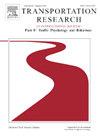Cross-national differences in drivers’ eye contact and traffic violations: An online survey across 20 countries
IF 3.5
2区 工程技术
Q1 PSYCHOLOGY, APPLIED
Transportation Research Part F-Traffic Psychology and Behaviour
Pub Date : 2025-02-01
DOI:10.1016/j.trf.2024.12.021
引用次数: 0
Abstract
The advent of self-driving cars has sparked discussions about eye contact in traffic, particularly due to challenges that automated vehicles face in non-verbal communication with human road users. In his 1992 book, Turn Signals Are The Facial Expressions Of Automobiles, Don Norman describes how drivers in Mexico City deliberately avoid eye contact when entering a roundabout to create uncertainty in the minds of other drivers, leading the latter to yield right of way. Norman argued that such manipulative or aggressive behavior would not be tolerated in the United States. In the present study, we tested these claims through an online survey involving 3,857 respondents from 20 countries. The results confirmed that Mexican drivers reported a higher frequency of non-speeding ‘aggressive’ violations compared to those from most other countries. Regarding eye contact in the roundabout scenario presented in the survey, national differences were found not so much in the frequency of eye contact but in the reasons behind its use. Mexican drivers tended to avoid eye contact to reduce tension or avoid conflict with other drivers. However, they also frequently reported making eye contact to assert or subtly enforce their right of way. In higher-income countries like the United States, driver-driver eye contact is often deemed unnecessary. In conclusion, our findings partially correspond with Norman’s anecdote based on his experiences in 1950s Mexico City. These results may have implications for understanding the stability of traffic cultures and the challenges related to eye contact and non-verbal communication faced by developers of automated vehicles.
求助全文
约1分钟内获得全文
求助全文
来源期刊
CiteScore
7.60
自引率
14.60%
发文量
239
审稿时长
71 days
期刊介绍:
Transportation Research Part F: Traffic Psychology and Behaviour focuses on the behavioural and psychological aspects of traffic and transport. The aim of the journal is to enhance theory development, improve the quality of empirical studies and to stimulate the application of research findings in practice. TRF provides a focus and a means of communication for the considerable amount of research activities that are now being carried out in this field. The journal provides a forum for transportation researchers, psychologists, ergonomists, engineers and policy-makers with an interest in traffic and transport psychology.

 求助内容:
求助内容: 应助结果提醒方式:
应助结果提醒方式:


